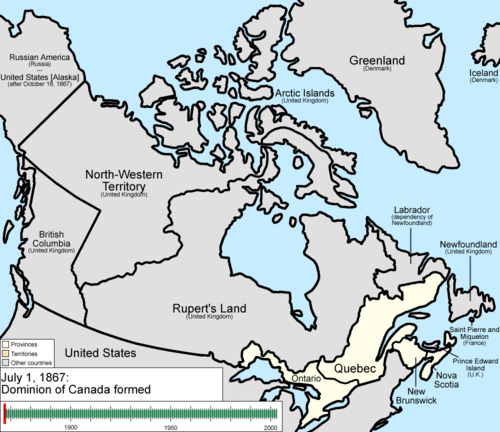Template:POTD/2015-07-01: Difference between revisions
Content deleted Content added
Wrong word |
NWT arrived in two stages, as the maps show, and part of Nunavut is from the 1880 land |
||
| Line 8: | Line 8: | ||
A map showing the '''[[territorial evolution of Canada]]'''. After [[Canadian Confederation|Confederation]] in 1867, four provinces ([[Ontario]], [[Quebec]], [[New Brunswick]], and [[Labrador]]) were established from three British colonies. This nascent country continued to accrete new [[provinces and territories of Canada|provinces and territories]], including [[Manitoba]] in 1870, [[British Columbia]] in 1871, [[Prince Edward Island]] in 1873, and [[Alberta]] and [[Saskatchewan]] in 1905; previously established provinces also expanded their borders. The most recent province to be added was [[Newfoundland and Labrador|Newfoundland]] in 1949; it has since been renamed Newfoundland and Labrador. |
A map showing the '''[[territorial evolution of Canada]]'''. After [[Canadian Confederation|Confederation]] in 1867, four provinces ([[Ontario]], [[Quebec]], [[New Brunswick]], and [[Labrador]]) were established from three British colonies. This nascent country continued to accrete new [[provinces and territories of Canada|provinces and territories]], including [[Manitoba]] in 1870, [[British Columbia]] in 1871, [[Prince Edward Island]] in 1873, and [[Alberta]] and [[Saskatchewan]] in 1905; previously established provinces also expanded their borders. The most recent province to be added was [[Newfoundland and Labrador|Newfoundland]] in 1949; it has since been renamed Newfoundland and Labrador. |
||
Since its cession to Canada in 1870, land belonging to the [[Northwest Territories]] has been used to establish new provinces and territories several times. Aside from the provinces mentioned above, this includes [[Yukon]] in 1898, and [[Nunavut]] in 1999. |
Since its cession to Canada in 1870 and 1880, land belonging to the [[Northwest Territories]] has been used to establish new provinces and territories several times. Aside from the provinces mentioned above, this includes [[Yukon]] in 1898, and [[Nunavut]] in 1999. |
||
|credit=Animation: [[user:Golbez|Golbez]] |
|credit=Animation: [[user:Golbez|Golbez]] |
||
Revision as of 19:30, 25 June 2015
A map showing the territorial evolution of Canada. After Confederation in 1867, four provinces (Ontario, Quebec, New Brunswick, and Labrador) were established from three British colonies. This nascent country continued to accrete new provinces and territories, including Manitoba in 1870, British Columbia in 1871, Prince Edward Island in 1873, and Alberta and Saskatchewan in 1905; previously established provinces also expanded their borders. The most recent province to be added was Newfoundland in 1949; it has since been renamed Newfoundland and Labrador.
Since its cession to Canada in 1870 and 1880, land belonging to the Northwest Territories has been used to establish new provinces and territories several times. Aside from the provinces mentioned above, this includes Yukon in 1898, and Nunavut in 1999.Animation: Golbez

